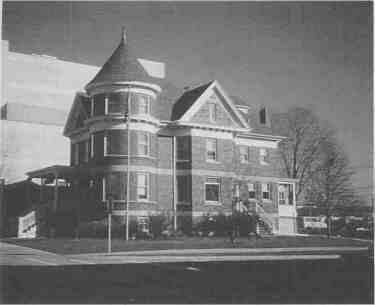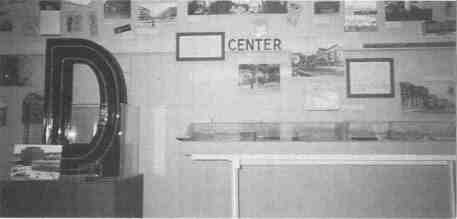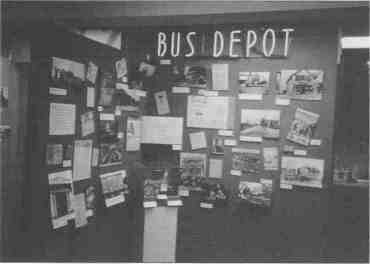SPECIAL FOCUS
MUSEUM 101
A quick education in these unique facilities, which are often forgotten in
our world of multi-million dollar recreation centers and aquatic parks
BY JOY A. MATTHIESSEN
|
Is it possible that
people who talk
about pH in a pool
can work
cooperatively with
people who talk
about pH in paper?
|
What do swimming pools, fitness centers, golf
courses, sled hills and museums have in common?
Very often, they are among the richly diverse
elements under the jurisdiction of a local park
district. Each facility serves its own special interests,
but at times it appears the museum facility is a lesser
priority. Generally, this has more to do with not
understanding what it is that museum people do or
where the museum "fits" within the structure of
neighborhood parks, day camps and skating rinks.
Yet, a museum can play a vital role if given the
opportunity to grow and thrive within a park and
recreation agency.
So, how does a museum carve its niche in a park
district?
In Des Plaines, for example, when a need arose to
hire a full-time director to operate the museum
facility, the park district became a partner in an
intergovernmental agreement between the city of
Des Plaines, the park district and the historical
society. Sometimes, as is the case for Buffalo Grove, a
piece of property is given with the idea that it will be
used as a museum. In others, the park district takes
on properties that otherwise might be demolished,
such as the case with the Morton Grove Park District
working in conjunction with the historical society.
(See related museum partnership story on page 40.)
Museums do have some technical issues that
usually are best served by someone trained in
museum studies or historical administration. Just as a
curator more than likely will not know what to do
about algae in a pool, neither should it be assumed
that a parks and recreation professional will know
what to do about mold on a photograph. Is it
possible that people who talk about pH in a pool can
work cooperatively with people who talk about pH in
paper? Of course, but it takes some time to educate
everyone and get people on track to work together.
A Day in the Life of a Museum
While there is not a typical scenario, a day at the
Des Plaines Historical Museum might include
accepting donations, cleaning furnishings within the
period room setting, dismantling an exhibit, escorting a tour group, assisting researchers and volunteers,
overseeing the work of contractors and paying bills.
Doesn't sound too difficult, does it? Let's take a
closer look at what's happening.
For example, processing a donation (which means,
in part, accepting it into the collection), involves
obtaining a signed agreement from the donor, doing
necessary research on the object(s) and completing
the appropriate accession record paperwork.
First, things must be "accessioned." Accessioning
artifacts can be compared to a park district processing
fixed assets. An accession number—which is a unique
number given an artifact when it comes into the collection—is assigned to each piece and then affixed in
the proper manner deemed by the makeup of the artifact. Some accession numbers are "painted" onto an
artifact (e.g., glassware and furniture) using special
January/February 1999 /29
|

Photo: Opened in 1969, the
Des Plaines Historical Museum
operates
under an
intergovernmental agreement
between the Des Plaines
Historical Society, Des Plaines
Park District and the city of Des
Plaines.
|
materials that can be removed, should it be necessary,
without harming the object. Other objects may be
marked with an acid-free tag. Most paper objects get a
number printed on them with a no. 2 pencil.
Depending on the number of objects in a particular
donation, processing may take anywhere from a few
hours to more than a year in the case of large archival
donations. These sometimes can include thousands of
pieces of paper ephemera. In such a situation, it may
take a volunteer and/or curator five to ten hours per
week to fully inventory the materials and ready them
for use by researchers.
The "Simple" Task of Cleaning
Cleaning isn't such a complicated thing, or is it?
Just as a pool and the nacho machines at the
concession stand require special cleaning, so does
furniture in a period room setting. That means no
furniture sprays or polish. Only cotton material is used
for dusting, and when the floor needs washing, an
inert "soap" product is used which leaves no residue
behind.
|
Objects must be handled and moved with utmost
care. Chairs are lifted from the seat since it is the
sturdiest part, while lifting from the back may spell
doom for a century old piece. Of course, whoever is
doing the moving is wearing white cotton gloves so
that dirt and oils from the hands does not transfer to
the object and some things, like fine silver, will carry a
fingerprint forever if you are not careful. These
artifacts are held in public trust, and all personnel,
both staff and volunteers, working with the objects
receive training to do the job properly.
|
"From my experience, some of the best
museums in the area are ones with
agreements involving park districts
or the municipality."
- Joy Matthiessen, director of the
Des Plaines Historical Society
|
Preparing Museum Exhibits
To illustrate the work involved in preparing a
museum exhibit, let's look at the Des Plaines
Historical Museum. Its current exhibit, "The
Changing Face of Downtown Des Plaines," took
approximately 200 hours to research. More than 300
three-dimensional objects, photographs and other
paper memorabilia were installed. Photographs and
advertisements were reproduced and mounted on
acid-free foamcore and mat board. Inert mylar or
ethafoam barriers were placed between all objects and
the surfaces to which they were affixed. Each object
has been carefully protected for the duration of the
exhibit.
In all, five staff and six volunteers spent approximately 800 hours on the installation. The movement
of all objects from their various storage locations was
tracked via the museum's collections management
software. Deinstallation this January will take another
200 to 300 hours.
How Museums Benefit Park Districts
So, it's clear that museums require specialized
processes and painstaking work. What, then, can a
museum offer the park district environment? In the
case of a historical museum, there is an opportunity
to provide unique educational programs that bridge
past and present.
Many park districts are already offering courses
such as "pioneer cooking" and "little schoolhouse on
the prairie" at museum facilities. There are some
potential drawbacks, however, especially when the
museum is in an old house. Generally, these facilities
were built to be family homes, and activity space is at
a premium. Structurally, they may not be up to the
wear and tear of hundreds of visitors weekly. Therefore, a small house museum might not be able to
accommodate the crowds that park districts often
30/ Illinois Parks and Recreation
|

The museum's
exhibit showcases downtown
Des Plaines. Dismantling the
exhibit this
January will take 200
to 300 hours.
|
anticipate for a program. In Des Plaines, the museum
is on a small corner lot and it does not accommodate
large groups unless one of the streets is blocked off. At
times, we find it necessary to take our programs to
park district facilities.
From my experience, some of the best museums in
the area are ones with agreements involving park
districts or the municipality. For smaller museums,
such an affiliation can help provide a vital base of
support, not only monetary, but in expanded people
resources and services.
|
Des Plaines' intergovernmental agreement spells
out the responsibilities of each of the three parties
involved with the historical society board acting as the
overseer of the museum. The park district and city are
represented by voting liaisons. Due to this cooperation, many projects are tackled that might otherwise
go unheeded until the brink of desperation. Last year,
for example, the museum got both a new roof and
heating system through the entities working together.
In addition, the park district has allowed the
historical society use of a room in its administration
building which serves as off-site storage for approximately 5,000 three-dimensional objects and 75 square
feet of boxed archival materials. Today, the 800-plus-square-foot space is organized with shelving units
stretching from floor to ceiling with objects filed in
Nomenclature order.
|

This neon "Bus
Depot" sign is one of the
hundreds or items in the
Des
Plaines Historical Museum's
exhibit on downtown Des
Plaines.
|
Unfortunately, that was not always the case. In
1993, the museum staff and volunteers undertook a
massive overhaul of the room which at one time was
referred to as a "junk pile." Since the historical society
actively collects memorabilia relating to the history of
Des Plaines, this space has become vital to the
operation of the museum and enables us to keep
collecting. This is especially appreciated when the
park district itself could utilize the space.
Another benefit of our collaboration is the ability to
advertise museum programs, workshops and events in
the Des Plaines park district Spectrum. Each issue
includes a page of upcoming offerings such as
"Preserving Family History," with an emphasis on
creating family memories; "Homemade Holiday
Decorations" featuring authentic turn-of-the-century
patterns; as well as culturally diverse crafts and the
July 4th ice cream social. This vehicle enables us to
reach 22,000 households in the community.
|
Be sure to include your local museum in efforts to
"create memories," "promote sensitivity to cultural
diversity" and "increase community pride." By
working together, with mutual respect, much more
can be accomplished, and the benefits are endless. •
JOY A. MATTHIESSEN
is the museum director for the Des Plaines Historical Museum. She's served in that
position for the past nine years and holds a master's degree in Historical
Administration from Eastern Illinois University.
January/February 1999 /31


